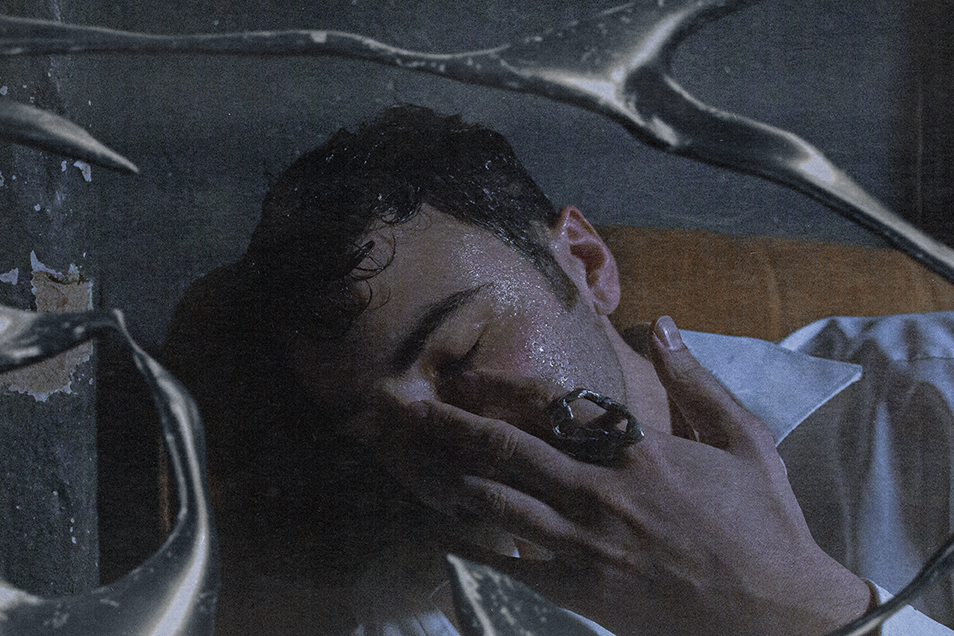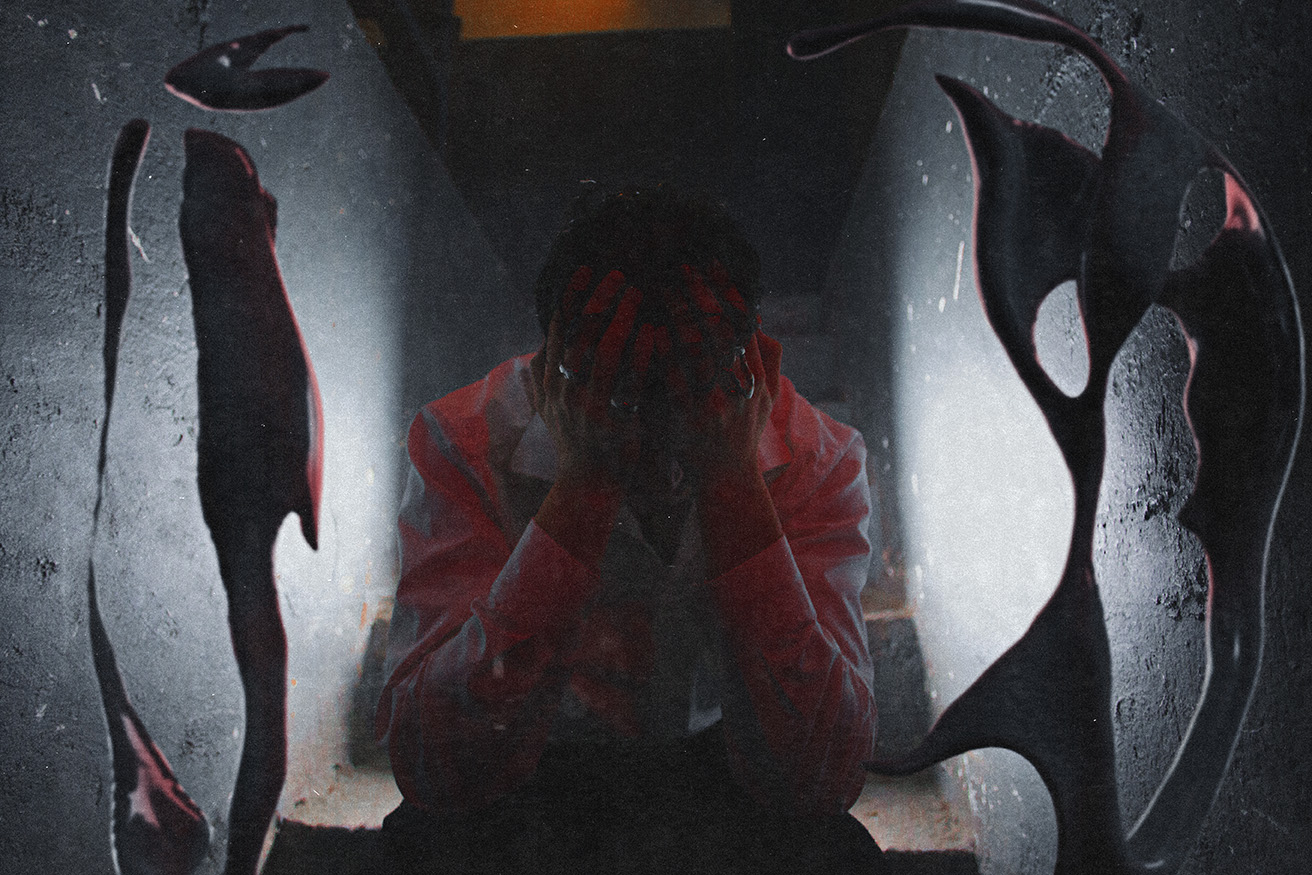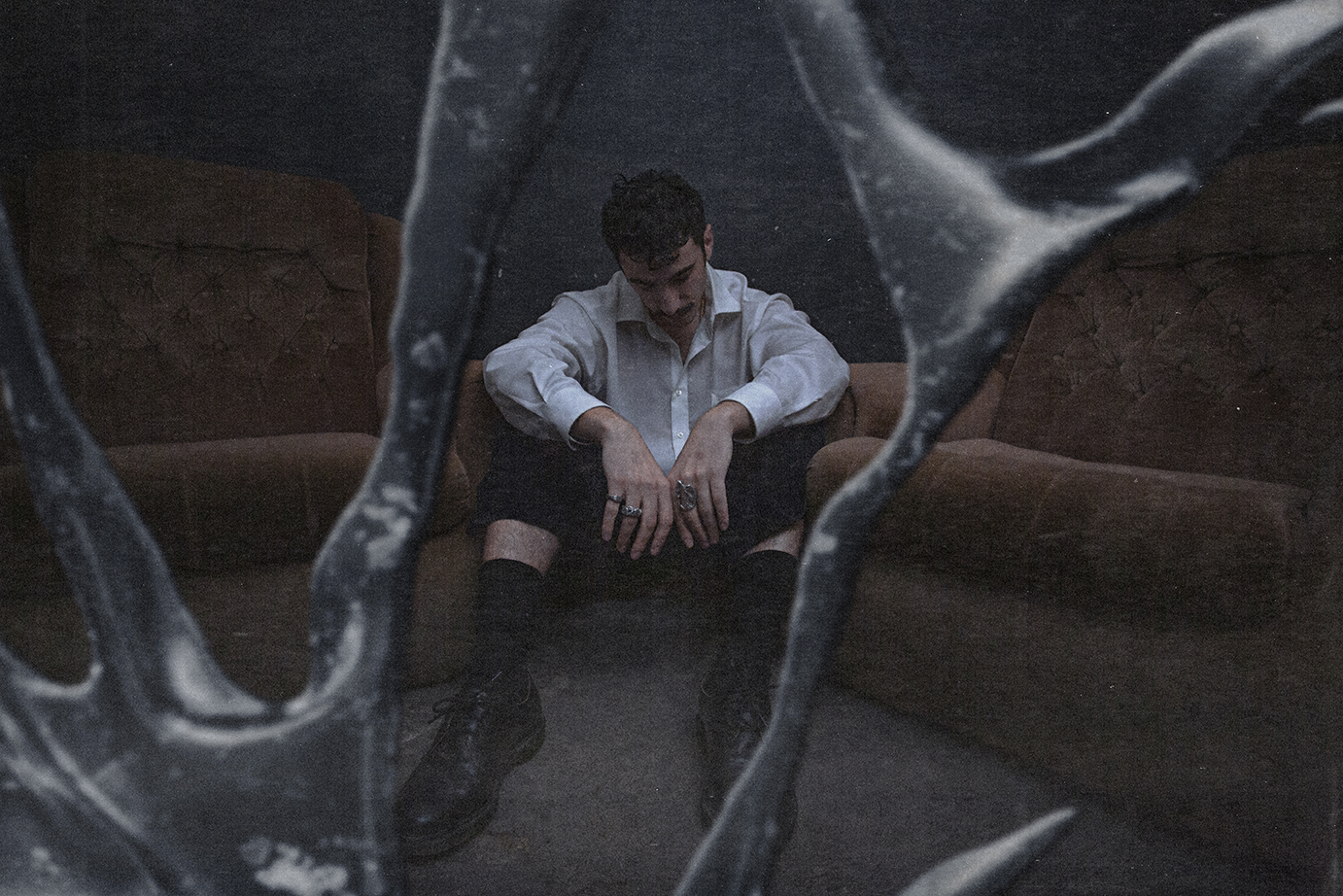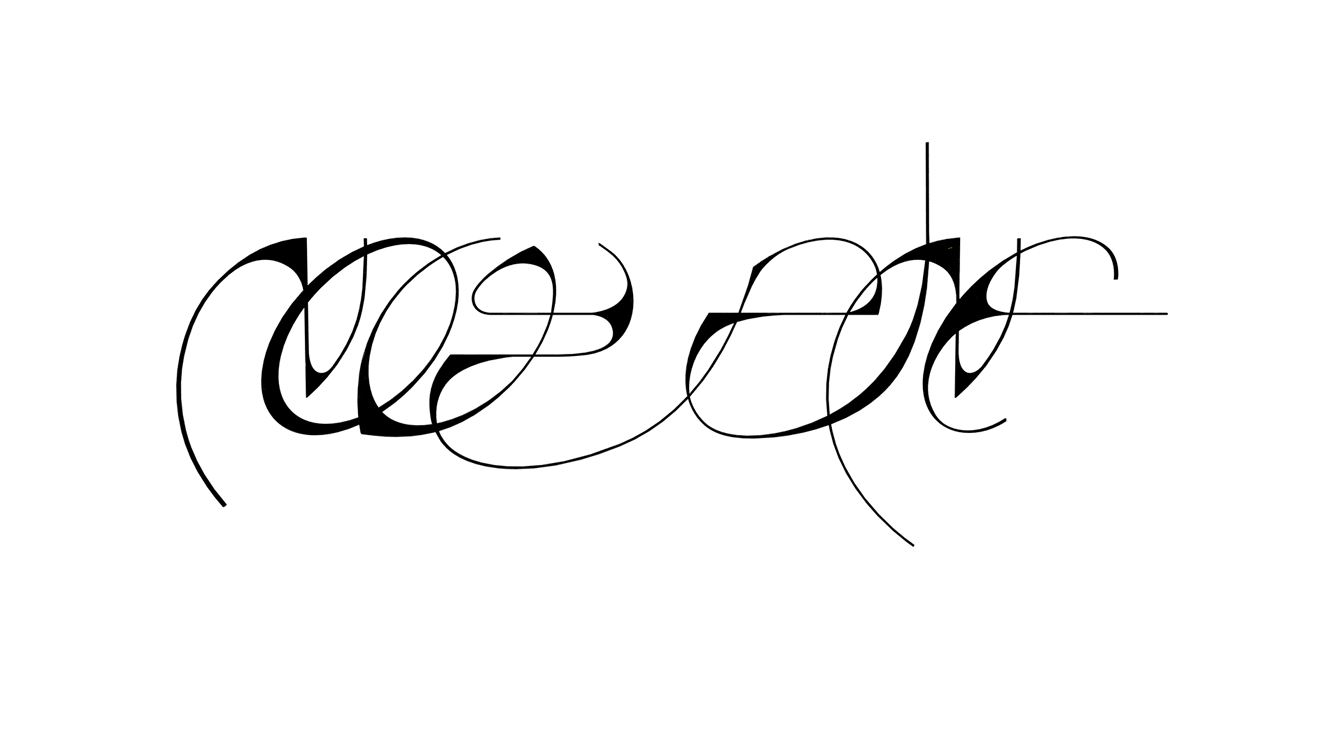IRYNA DRAHUN
Visual artist, Iryna Drahun: “Physical reality has moved to the digital world. All that’s left for me to do is to create in between these two worlds”
Interviewed by David Laufer


photography and digital art IRYNA DRAHUN
model SANDRO MAKHATADZE
rings SIMON KOUNOVSKY
model SANDRO MAKHATADZE
rings SIMON KOUNOVSKY
In her practise, Iryna Drahun (alias India Ray) combines photography and 3D art, and connects natural and virtual worlds together. Originally from Belarus, she now lives in Prague where she studies in the Atelier of Photography I at UMPRUM. Scrolling through her Instagram feed, you will encounter photos of jewellery lying on alienesque crystals, nature, and faces surrounded by flowing virtual mass or photos from the backstages of catwalks. What you don’t know however, scrolling through her photos, is that you aren’t stalking her - she’s stalking you. Specifically on her second Instagram profile @istalkyouu__, she captures the wonderful moments, and fashion decisions, of people in the streets of Prague. She is currently nominated for Photographer of the Year by Czech Grand Design, for her work for We’re Next Prague, Radio Wave or Mia Jadrna.
Your visual Where did everyone go, in collaboration with Simon Kounovsky (@axonbody), seems to reflect current reality - an empty club, a chill out zone lacking people, a dejected atmosphere…
That’s right. Lockdown has had an impact on all spheres of life, including the entertainment industry. We are stuck inside, we can’t visit our friends and we miss loud parties. We want to experience the feelings that come with being on a dance floor: the euphoria from a great line-up and the exhaustion after a long rave. We tried to recreate this atmosphere somehow. Simon Kounovsky created a series of rings for the project, but rather than showcasing the rings, we wanted to tell a story. In order to come as close to reality as possible, we put a large emphasis on authentic clothing and we photographed the project in Prague’s club Ankali. Our goal was to demonstrate the moment when one is continuously dancing until the very morning and suddenly the music stops and light switches on. In that moment, they are lost, frustrated, aren’t able to find their friends and realise that they were left alone. Like a lost ghost. Something similar to what we are currently experiencing in isolation.

photography and digital art IRYNA DRAHUN
model SANDRO MAKHATADZE
rings SIMON KOUNOVSKY
model SANDRO MAKHATADZE
rings SIMON KOUNOVSKY
I noticed that you often enrich reality with something special, after all, even in the mentioned photography medium, the 3D aspect plays a major role. Why exactly is this borderline between realties interesting to you?
I like to explore, experiment and find new instruments through which to communicate with the audience. This is precisely what led me to 3D art. The digital objects that we see are an imitation of Simon’s rings - they copy their form and texture, and together they aim to resemble some kind of symbiotic organism. The viewer will hardly notice the small pieces of jewellery, so I created a visual game of "big and small”, projecting the jewellery over the whole of the photo. It serves as a kind of complement to reality, which I think has great potential overall. Today’s digital world dominates over the physical, where we, for instance, spend more time consuming digital data than food. I don’t think this is necessarily wrong, it’s an important element defining this era. This is why I want to be a guide through these worlds, digital and physical, and to add something special to reality. I find that playing with real and unreal worlds is extremely interesting. It adds a completely different flavour to the photos.
Do you think that your project @istalkyouu_ does a similar thing? Even though you are, on the contrary, depicting authenticity as opposed to digital “artificiality”, doesn’t it still offer a glimpse of something that’s special within everyday reality?
I stalk you serves as a source for inspiration. I tend to get inspired by everyday situations quite a lot - and documentation of the streets is a representation of reality that you won’t be able to find on Netflix, on the news or on the television. A lot of people don’t even notice such situations either. I take pictures of random people in random moments - people who often move on the fringes of societal norms. For me, I stalk you is a low budget version of Black mirror with good actors, and maybe an even deeper meaning. It’s a kind of a social mirror, in which I try not to act as an artist, but rather I try to broadcast something along the lines of social flares. Here, too, I enjoy guiding the viewer between what exists and what people refuse to notice. It is a very important part of my work.

photography and digital art IRYNA DRAHUN
model SANDRO MAKHATADZE
rings SIMON KOUNOVSKY
model SANDRO MAKHATADZE
rings SIMON KOUNOVSKY
Where in your work, do you think, could one find a socio-political dimension?
Questions regarding politics, society, the environment, and personal topics, too, are very important to me. I like to refer to them mostly in the work that I do during my studies, as this is when I can create something for myself. I don't have these works showcased directly on Instagram, Instagram holds more of a commercial and networking meaning for me. Last semester for instance, my final project commented on the situation in Belarus. You probably know what’s going on there. The topic pains me a lot and because my parents and many of my friends are still there, I know what is actually happening. When you live in Europe, the police have to take care of you, and for instance, the police in Czechia are fulfilling this role very well in comparison to what is happening in Belarus. For me, what is going on there at the moment, is completely incomprehensible. This just shouldn’t be happening in 2021. Political issues therefore have a lot to do with my personal life as well - and that’s why they definitely reflect in my work.
You are nominated for the Czech Grand Design photography price, largely thanks to your fashion photography work. I heard, however, that you want to pursue this practise less. Why?
I don’t want fashion to be the only thing I photograph. I am finding that I need space for my projects in other areas as well. For instance, I’d like to focus more on personal topics and political issues. In my opinion, art should reflect current events. My aim isn’t to change the world, but I’d like to be able to reflect what happens in it. Doing so, through fashion, seems a bit superficial to me. It’s a good visual accessory, but I don’t want fashion to be the central element of my practise. Although photographing it is great and I will keep doing it, I am presenting my photographic skills through it, rather than myself as an artist.
In fashion photography - and commerce overall - the emphasis on the visual side of things is quite prominent. Do you think that experiencing this has an influence on your work?
I think that my visual creations don’t really correspond much to traditional notions of aesthetics. I come from an alternative artistic environment, I am most inspired by contemporary electronic music: techno, post-club and the club scene in general. If I then have a chance to create a commercial product with such an aesthetic, then why not, but this isn’t my main goal. Lately, I’ve been feeling a strange nostalgia for memories of being fifteen, and being a goth, listening to My Chemical Romance, Nightwish - and so on. Now I listen to rock quite a lot, too. I’m hoping that this music will come back in a more contemporary form. I'm really looking forward to it, because we see the same kind of cycle repeating itself in fashion, and in an interesting way. It works the same for music.
How important are aesthetics and visuals in your work?
Aesthetics are the most important aspect of my photography. Nobody cares about your concept - if it looks bad, everyone will say that it’s bad. We live in an era of Instagram and TikTok, and taste is formed in the virtual space of the Internet, where the visual side takes on a key role. I’m unable to say if that’s good or bad. Even on my Instagram, this is the way it is, people want to see something interesting, even if it isn’t necessarily beautiful. Recently I saw an Instagram profile of a celebrity, who was last active a year ago. Almost all of the comments expressed sincere condolences. Being offline today means death. Everything exists in the online realm and there are no longer any topics left, which do not have their form, and visual content, on the Internet. Physical reality has moved into the visual world, and the only thing that’s left for me to do, is to artistically move in between the two.
The shift into the digital world was further accelerated by Covid. For over a year now, it has been testing the ability of galleries to digitise exhibitions, or exhibit purely digital. Are Czech galleries ready for new media, both technically and in terms of their interest?
This is a very current topic for galleries, because they put on exhibitions throughout Covid, but with a limited capacity of visitors. Unfortunately, the current situation robs us young artists of time, because we should be exhibiting as much as possible while we are still at school. When lockdown ends, a number of us would have already finished studying. And if we’ve had no exhibitions, there will no longer be an interest in us, and we will be replaced by the new generation of artists coming from schools. We are now finishing our Bachelors degree and then that’s it. This is our time. We should be presenting our works in galleries. They, however, have only one option, which is to hold online exhibitions. In my opinion, they weren’t ever really prepared for this. Fortunately for me, lockdown has not been such a problem, all I need is a computer. But artists working with different mediums need studios and materials, to which they don’t currently have access. It is a catastrophe for them.
In recent years, we have also seen occasional attempts at using VR and AR in exhibitions. In your opinion, is a broader connection between similar new media and gallery space the way forward?
Yes, I think so. The technologicalization of society requires more and more skills, and the adaptation of new technologies. For instance in South Korea, they are working on an AR/VR project which would allow us to feel, and smell, flavours and scents. It sounds unreal, but it’s basically reality. Humanity has a tremendous ability to create beautiful things, but also unfortunately, to destroy the planet. I’m noticing that in Czechia, the interest in new media, amongst younger artists, is growing. The final projects at FAMU, AVU and UMPRUM were a clear example of this. In my opinion, in a couple of years, work with 3D softwares will become a basic subject. It would be fun if we had mandatory 3D courses, alongside learning traditional techniques of drawing and painting. I think this will become completely normal, eventually.
Even your commercial work can often look like a free-flowing work of art. Do you try to be as unlimited as possible, by the need to promote the product?
The advantage of photography is that, even when it comes to collaborations, I still have space for my own expression. Usually people want photos from a specific photographer because they like their work. The photographer should therefore have a visual DNA that they bring into their own projects. The dramaturgy of the visual side will inevitably change, because it will involve the designer or someone else. It’s important not to loose oneself in these projects. That’s what I’m always trying to do. Not to lose myself.
How is the commercialisation of new media art, now? Are there enough clients in Czechia, whether this is in the fashion, jewellery, music or other industries?
I don’t want to complain, but it’s very hard. I think this is just the price I have to pay for staying within the visual sphere of my work. I understand that my visual language won’t resonate with everyone. Maybe if I was to be constantly doing simple commercial work for bigger brands, I’d have loads of money. This would, for me as an artist, mean death. Commerce in Czechia doesn’t function differently to this otherwise. People aren’t used to paying large enough fees to photographers or 3D artists. As well as that, I tend to work with friends, so I try to give them a friendly price.
Can't this connection with commerce be achieved, for instance, through digital fashion, virtual fashion shows, and digital models?
This could, maybe, be a great combination, I am just not able to imagine it. Digital fashion is great, for instance, for computer games, but for me the cherry on the top is being able to feel the fabric, cut, and everything in physical form. But with new technologies, we usually never know how they will develop, which is what I like about them. Future technology might surprise us. And even though I might not like it now, it might turn out to be something great. Then I'll say to myself, "Yeah, that's a great idea. I should have come up with that myself”.
What do you think is the future of digital fashion in Czechia?
I saw a couple of attempts at it on the Internet, however, what I think Czech 3D artists are lacking, is patience. When I see some of their works, I often think that they still need a bit of time and effort to achieve a greater level. It’s a technical matter - and you have to watch a lot of tutorials. It’s not enough to just render something. But I don’t want to be a critic, I mean well. All of the work has potential. All it really needs is just a bit more patience. Maybe then it will really become a compulsory subject at UMPRUM - and it will all be fine. For now, I’m just hoping I won’t have to be the one teaching it.
See the Czech version of this article together with visual artworks in NOVY ZINE, issue 1.
